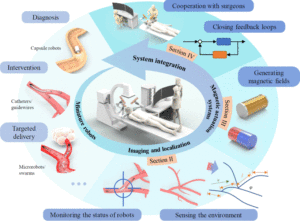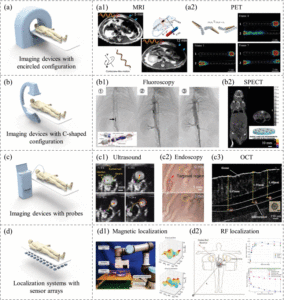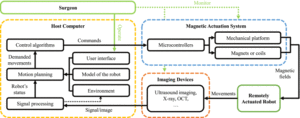Small-scale machines that can travel freely inside the body to treat diseases have attracted extensive attention due to their minimal invasiveness, which can reduce trauma, the risk of infection, and pain after an operation and shorten recovery time. Magnetic miniature robots are promising tools for minimally invasive and noninvasive therapy. With decades of development, magnetically actuated miniature robots have been stepping toward becoming a feasible tool for minimally invasive and noninvasive surgeries.
In an article published in IEEE Transactions on Robotics, researchers have summarized the image-integrated magnetic actuation systems solutions for automated surgeries. A framework for cooperation between magnetic actuation systems, imaging systems, and miniature robots is discussed. The advantages and drawbacks of reported techniques, major challenges, and potential prospects in this field are also outlined.
Among various remote actuation methods, according to the authors, magnetic fields show high potential in medical scenarios owing to their high safety, deep tissue penetration, and fast response. Since the early 1900s, magnetic fields have been implemented to treat patients, and commercialized systems of the 2000s have led the magnetic actuation technique closer to patients. With decades of development, precisely controlled magnetic actuation systems have improved the controllability and higher motion dexterity of medical miniature robots.
On the road toward safe, practical, and automated surgical procedures, tracking and controlling the miniature robots will be the bridge that connects the fundamental research in labs to the applications in clinics. Building the next-generation systems with actuation-perception loops are key points to guarantee operation safety and to realize automated/half-automated surgery. Cooperation between the magnetic actuation system, miniature robots, and in vivo tracking is an essential step.

Key elements of image-integrated magnetic actuation systems, including miniature robots, imaging and localization methods, magnetic actuation systems, and system integration strategies
Imaging and Localization of Miniature Robots
Monitoring the status of the robot during operation is critical to ensure safety and provide feedback for demanded tasks. In the article, the authors outline miniature robots’ imaging and localization methods, categorized based on device configuration, to better discuss the integration methods with magnetic actuation systems.
- A. Imaging Devices with Encircled Configuration: Many imaging devices are designed to encircle patients during the imaging process. Typically, devices such as magnetic resonance imaging (MRI), X-ray computed tomography (X-ray CT), and positron emission tomography (PET) have encircled configurations.
- B. Imaging Devices with C-Shaped Configuration: Medical imaging devices with a C-shaped configuration have two separate components for imaging, between which the patient lies down.
- C. Imaging Devices with Probes: Devices for ultrasound and optical imaging typically have probe-like structures. The imaging function is integrated into a hand-held probe, which can scan from the skin or be inserted into the patient’s body.
D. Tracking Systems with Sensor Arrays: Besides the medical imaging techniques, magnetic miniature robots can also be localized using sensors.

Imaging and localization devices for miniature robots.
Applications of Image-Integrated Magnetic Actuation Systems
According to the researchers, integration between magnetic actuation systems and localization devices is crucial. The main modules of a system include the magnetic actuation system, miniature robots, imaging devices, and host computers. Magnetic forces are usually implemented for specific operations, such as drug release and biopsy. The miniature robot serves as an end-effector to perform required tasks inside a human body. The imaging devices monitor the status of the miniature robots and provide feedback to the host computer, which coordinates the entire operation process.
A user interface is also necessary to help the surgeon with convenient operations, and commands from the surgeon can also be executed in real-time. During the operation, the surgeon should have the highest priority to control the system and monitor the status in real-time. The surgeon shall have the right to override the system’s operation if necessary.

General framework of image-integrated magnetic actuation systems.
The authors note that the working space for magnetic actuation systems in actual procedures will be more complicated than those in labs—due to the existence of patients, surgeons, and other medical devices. Image-integrated magnetic actuation systems are widely used in the automatic control of small-scale robots. Cooperation between the system and the surgeons is essential during operations. The patient’s body and other medical devices can obstruct the workspace, which must be avoided when generating required magnetic fields.
Challenges & Additional Research
According to the researchers, although significant progress and achievements have been made in image-integrated magnetic actuation systems, challenges still exist toward practical applications. Enhancing the functionalities of remotely actuated miniature robots would allow more surgical procedures. The developments of smart materials and biological technologies can give miniature robots more diagnostic and therapeutic functions.
For many years, magnetically actuated miniature robots have been designed for automated minimally invasive and noninvasive surgeries. Realizing these applications will require further development of image-integrated magnetic actuation systems. With additional developments, image-integrated magnetic actuation systems can make magnetic miniature robots a revolutionary tool in medical practices.
Interested in learning more about Robotics? IEEE offers continuing education with the IEEE eLearning Library to smartly implement digital tools into your organization.
Interested in acquiring full-text access to this collection for your entire organization? Request a free demo and trial subscription for your organization.





